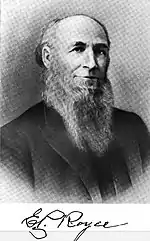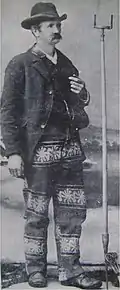Eli Parsons Royce
Eli Parsons Royce (November 29, 1820 – May 26, 1912) was an American surveyor in and around Green Bay, Wisconsin. He worked for various lumbermen, one who was Nelson Ludington a lumber baron that was doing work for a new railroad and harbor. The new harbor was the site of a new town later to be known as the city of Escanaba, Michigan. Royce surveyed the area for a layout of a new town as a pioneer and is considered the founder of Escanaba. There he was a businessman, surveyor, engineer, postmaster, and lawyer as well as their mayor.
Eli Parsons Royce | |
|---|---|
 | |
| Born | November 29, 1820 Clinton, New York, United States |
| Died | May 26, 1912 (aged 91) Escanaba, Michigan, United States |
| Nationality | American |
| Occupation | Surveyor |
| Employer | self |
| Known for | founder of Escanaba, Michigan |
| Spouse(s) | Sarah J. Barras |
| Children | two |
Early life
Royce was born in Clinton, New York, on November 29, 1820.[1][2] His father, Phinehas Royce, was a Massachusetts-born Quaker. He married Deborah Parsons of Connecticut, who was the daughter of minister Jonathan Parsons, and they had five children. Royce was their fourth son.[3] He received his middle name from the maternal side of the family.[4]
Career
Royce grew up in Putnam County, New York, where he attended public schools. His parents moved to Ohio with the family when he was fifteen years old. There Royce got a job as a handyman helper to a corps of surveyors that were working in a timber area, 3 miles (4.8 km) west of Oberlin, Ohio. He learned field techniques in the process, such as being able to travel about without the use of a compass and not getting lost. He moved from the Oberlin area to Sandusky, Ohio and had different jobs. One was working at a horse railroad that was commissioned by the city of Sandusky. He worked in the construction and repair work of the railway, which was about 20 miles (32 km) miles long. After a year, he moved to Adrian, Michigan.[3]

During the next three years he worked on the railroad between Adrian and Hillsdale, Michigan. He also taught at a local school for two years. Royce later returned to Sandusky and from there went to Chicago by steamship. He got various jobs in Chicago then from 1840 to 1842. At this time, he became acquainted with William B. Ogden, Chicago's first mayor and worked with him doing surveying. Royce then went to Michigan City, Indiana, and worked surveying the shore of Lake Michigan and building piers. He later returned in mid-1849 to Chicago and was married to Sarah J. Barras,[2] a descendant of Colonel Barras. Sarah was born in the state of New York. They had two children.[5]
Royce moved from Chicago to Green Bay, Wisconsin and was employed in surveying for lumbermen. He was in charge of an exploration party which prospected for a railroad to be built west of the Wisconsin River.[5] Royce first explored the Escanaba territory in 1855. In 1861 lumberman Nelson Ludington requested Royce to explore Escanaba for a suitable harbor for the Upper Peninsula of Michigan. After doing surveying work for Ludington, he went back to his home in Green Bay. There he studied law and practiced in nearby Oconto, Wisconsin.[6]
Royce returned to the Escanaba area in 1862 and started to lay out a town.[2] He laid out the original town as it now stands and had it recorded in the county in 1864.[7] It was originally laid out as 42 blocks west from the bay and five blocks north and south of Ludington Street.[8] Many additions have since been made to the original recorded plat. Royce is the pioneering resident of Escanaba and was known in the Upper Peninsula as a businessman. He held city offices of postmaster, attorney, mayor, and engineer.[2][9] Royce eventually brought his family to the new town in 1864.[5]
Royce had taken an active part in local affairs as a citizen of the new town and is considered by historian Clint Dunathan as the founder of Escanaba, Michigan.[10][11] He is given the credit for the wide streets of the city he laid out as a surveyor.[5] The name "Escanaba" means flat rock in the Chippewa language of the indigenous American Indians. The Escanaba River bottom contains many smooth flat rocks made that way by the currents of the river. The name of the town was named after the river that received the Escanaba name first from the local Native Americans.[2] The city of Escanaba is in a narrow strip of land called Sand Point that juts out into a little bay that opens into Lake Michigan's Green Bay. This area was named by the local native American Indians as Weyohquatonk.[12]
Death
Royce died at the age of 91 on May 26, 1912. He is buried at the Lakeview Cemetery in Escanaba.[2][6]
References
- "Escanaba". Lansing State Journal. Lansing, Michigan. May 27, 1912. p. 2 – via newspapers.com
 .
. - Dunathan, Clint (June 29, 1963). "Royce Is Called City's Founder, Helped Name It". Escanaba Daily Press. Escanaba, Michigan. p. 110 – via newspapers.com
 .
. Nelson Ludington gave the name of the City of Escanaba.
- Sawyer 1911, p. 1394.
- Dickson 2002, p. 53.
- Sawyer 1911, p. 1395.
- "Founder of Escanaba is taken by death at 91". Detroit Free Press. Detroit, Michigan. May 27, 1912. p. 6 – via newspapers.com
 .
. A few years later he made the expedition which led to the founding of Escanaba.
- Charles, Vader (November 1, 2007). "Escanaba". Michigan History Magazine. High Beam Research. Archived from the original on November 18, 2018. Retrieved May 5, 2017.
- "Escanaba: The Port". The Historical Marker Database. 2020. Retrieved September 28, 2020.
- Dunathan, Clint (April 25, 1969). "Post Office Downtown Anchor". The Escanaba Daily Press. Escanaba, Michigan. p. 5 – via newspapers.com
 .
. - Dunathan 1963, p. 27.
- Nursey 1890, p. 18.
- "Escanaba Progress 1830–1916". Michigan History Magazine. Michigan Pioneer and Historical Society. 1917. p. 356. Retrieved September 28, 2020.
Sources
- Dickson, Karl (2002). Stories of Small Town Sports. K. Dickson.
- Dunathan, Clint (1963). The Century book. Photo Offset Printing Co.
For many years before his death May 26, 1912, Eli Parsons Royce was recognized as the 'founder and pioneer citizen' of Escanaba.
- Nursey, Walter R. (1890). City of Escanaba, Michigan. Lew A. Cates.
Mr. Royce may therefore be regarded as the patriarch of the Iron Port of the World.
- Sawyer, Alvah Littlefield (1911). A history of the northern peninsula of Michigan and its people. Lewis Publishing Company.
External links
| Wikimedia Commons has media related to Eli Parsons Royce. |